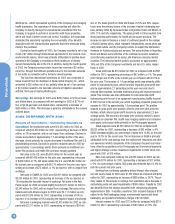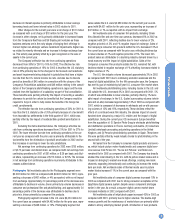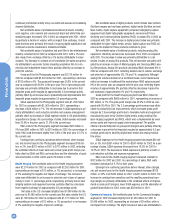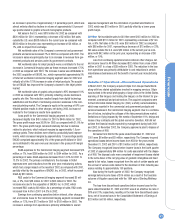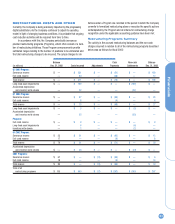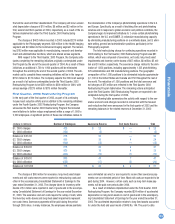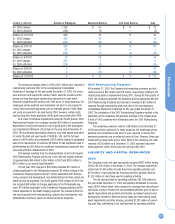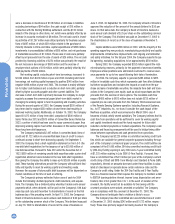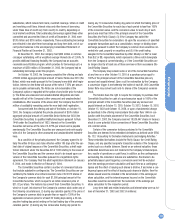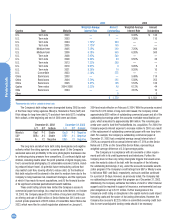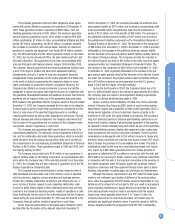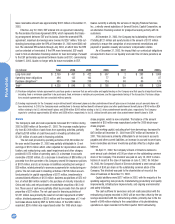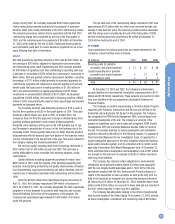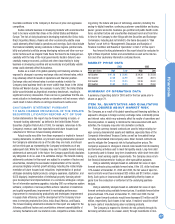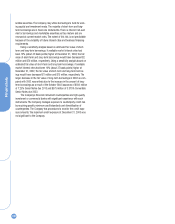Kodak 2003 Annual Report Download - page 28
Download and view the complete annual report
Please find page 28 of the 2003 Kodak annual report below. You can navigate through the pages in the report by either clicking on the pages listed below, or by using the keyword search tool below to find specific information within the annual report.
Financials
28
were a decrease in inventories of $128 million, an increase in liabilities
excluding borrowings of $94 million, the cash receipt of $19 million in
connection with the Sterling Winthrop settlement, and the $130 million
impact of the change in other items, net, which were partially offset by an
increase in accounts receivable of $9 million. The net cash used in invest-
ing activities of $1,267 million was utilized primarily for business acquisi-
tions of $697 million, of which $59 million related to the purchase of
minority interests in China and India, capital expenditures of $506 million,
investments in unconsolidated affiliates of $89 million, and net purchases
of marketable securities of $1 million. These uses of cash were partially
offset by net proceeds from the sale of assets of $26 million. The net cash
provided by financing activities of $270 million was primarily the result of
the net increase in borrowings of $588 million and the exercise of
employee stock options of $12 million, which were partially offset by divi-
dend payments of $330 million.
Net working capital, excluding short-term borrowings, increased to
$1,094 million from $474 million at year-end 2002. Including short-term
borrowings, net working capital increased to positive $148 million from
negative $968 million at year-end 2002. This increase is mainly attributa-
ble to higher cash balances and a reduction in short-term debt, partially
offset by higher accounts payable and other current liabilities. The
decrease in short-term debt is primarily because the Company no longer
regularly accesses the commercial paper (short-term debt) market in
managing its working capital to fund its operating and investing activities.
During the second quarter of 2003, the Company issued $550 million of
long-term debt to replace $550 million of short-term debt resulting in
improved working capital. Additionally, on October 10, 2003, the Company
issued $1,075 million of long-term debt, comprised of $500 million of
Senior Notes due 2013 and $575 million of Convertible Senior Notes due
2033, a portion of which has been used to repay commercial paper, thus
improving working capital. See further discussion in this section relating to
these long-term debt issuances.
The Company maintains $2,467 million in committed bank lines of
credit and $1,722 million in uncommitted bank lines of credit to ensure
continued access to short-term borrowing capacity. On September 5,
2003, the Company filed a shelf registration statement on Form S-3 (the
new debt shelf registration) for the issuance of up to $2,000 million of
new debt securities. Pursuant to Rule 429 under the Securities Act of
1933, $650 million of remaining unsold debt securities under a prior shelf
registration statement were included in the new debt shelf registration,
thus giving the Company the ability to issue up to $2,650 million in public
debt. These funding alternatives provide the Company with sufficient flexi-
bility and liquidity to meet its working capital and investing needs.
However, the success of future public debt issuances will be dependent on
market conditions at the time of such an offering.
The Company’s primary estimated future uses of cash for 2004
include the following: dividend payments, debt reductions, and acquisi-
tions. The Company has a dividend policy whereby it makes semi-annual
payments which, when declared, will be paid on the Company’s 10th busi-
ness day each July and December to shareholders of record on the first
business day of the preceding month. On April 15, 2003, the Company’s
Board of Directors declared a semi-annual cash dividend of $.90 per share
on the outstanding common stock of the Company. This dividend was paid
on July 16, 2003 to shareholders of record at the close of business on
June 2, 2003. On September 24, 2003, the Company’s Board of Directors
approved the reduction of the amount of the annual dividend to $.50 per
share. On that same date, the Company’s Board of Directors declared a
semi-annual cash dividend of $.25 per share on the outstanding common
stock of the Company. This dividend was paid on December 12, 2003 to
the shareholders of record as of the close of business on November 3,
2003.
Capital additions were $506 million in 2003, with the majority of the
spending supporting new products, manufacturing productivity and quality
improvements, infrastructure improvements, and ongoing environmental
and safety initiatives. For the full year 2004, the Company expects its cap-
ital spending, excluding acquisitions, to be approximately $550 million.
During 2003, the Company expended $252 million against the relat-
ed restructuring reserves, primarily for the payment of severance benefits.
Employees whose positions were eliminated could elect to receive sever-
ance payments for up to two years following their date of termination.
For 2004, the Company expects to generate $485 million to $615
million in investable cash flow, which represents cash flow after dividends
but before acquisitions and excludes the impacts on cash from the pur-
chase and sale of marketable securities, the impacts from debt and trans-
actions in the Company’s own equity, such as stock repurchases and the
proceeds from the exercise of stock options. The investable cash flow
range of $485 million to $615 million does not include $725 million of
expected pre-tax cash proceeds from the February 2004 announced sale
of the Remote Sensing Systems operation, including Research Systems,
Inc., to ITT Industries, Inc., nor does it consider the cash impact of the
NexPress acquisition, which was announced in March 2004, once it
becomes a Kodak wholly owned subsidiary. The Company believes that its
cash flow from operations will be sufficient to cover its working capital
and capital investment needs and the funds required for future debt
reduction, dividend payments or modest acquisitions. The Company’s cash
balances and financing arrangements will be used to bridge timing differ-
ences between expenditures and cash generated from operations.
The Company has $2,225 million in committed revolving credit facili-
ties, which are available for general corporate purposes including the sup-
port of the Company’s commercial paper program. The credit facilities are
comprised of the $1,000 million 364-day committed revolving credit facili-
ty (364-Day Facility) expiring in July 2004 and a 5-year committed facility
at $1,225 million expiring in July 2006 (5-Year Facility). If unused, they
have a commitment fee of $4.5 million per year at the Company’s current
credit rating of Baa3 and BBB- from Moody’s and Standard & Poors (S&P),
respectively. Interest on amounts borrowed under these facilities is calcu-
lated at rates based on spreads above certain reference rates and the
Company’s credit rating. Under the 364-Day Facility and 5-Year Facility,
there is a financial covenant that requires the Company to maintain a debt
to EBITDA (earnings before interest, income taxes, depreciation and amor-
tization) ratio of not greater than 3 to 1. In the event of violation of the
covenant, the facility would not be available for borrowing until the
covenant provisions were waived, amended or satisfied. The Company
was in compliance with this covenant at December 31, 2003. The
Company does not anticipate that a violation is likely to occur.
The Company has other committed and uncommitted lines of credit
at December 31, 2003 totaling $242 million and $1,722 million, respec-
tively. These lines primarily support borrowing needs of the Company’s


